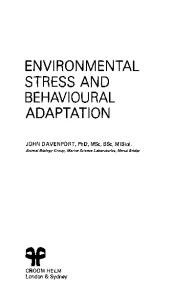Behavioural Responses
The behavioural responses of isopods have been studied since the turn of the century. The experimental conditions need to be held constant strictly enough to merit comparison in spite of the differences in technique. The procedure involved in my own studi
- PDF / 1,649,797 Bytes
- 13 Pages / 439.37 x 666.142 pts Page_size
- 113 Downloads / 311 Views
9.1 Experimental Procedure The behavioural responses of isopods have been studied since the turn of the century. The experimental conditions need to be held constant strictly enough to merit comparison in spite of the differences in technique. The procedure involved in my own studies consisted principally of two criteria (Warburg 1964), firstly, the behaviour of an individual and secondly, the behaviour of a small group of animals (up to 10). With the first criterion I used two procedures: measurement of the actual time spent in one place (condition) and counting the number of times (n) the animal shifted from one alternative to the other. Thus, I could calculate the percentage of time spent at each 'place' (or 'residence time'), as well as the speed at which an animal travelled from one place to another. These analytical indices could be used whether one used a choice-chamber apparatus (Fig. 9.1) or a temperature gradient apparatus (Fig. 9.2). In addition, it was possible to calculate the intensity of response (I); for details of these procedures, see Warburg 1964; Warburg and Berkovitz 1978a, b). With the experiments on groups of animals, another criterion was used of counting once every minute the positions held by each member of the group, without taking actual time measurements of their whereabouts.
9.2 Chemoreception Earlier work was reviewed by Wenig (1903). Abraham and Wolsky (1930a) described putative chemoreceptors on the 2nd maxilla of Porcellio scaber and Armadillidium vulgare. They studied in detail 15 species of isopods and noted chemoreceptors on the terminal segment of their antennae (Abraham and Wolsky 1930b). The fact that isopods respond to their own specific odours was shown by Kuenen and Nooteboom (1963) in Oniscus asellus, Porcellio scaber and Armadillidium vulgare. These species also respond to the odours of other species. Fischbach (1954) demonstrated that isopods react to odours produced by members of their own species. In that way, they are helped in locating suitable shelter. The
M. R. Warburg, Evolutionary Biology of Land Isopods © Springer-Verlag Berlin Heidelberg 1993
58
Behavioural Responses
9.1
9.2
Fig. 9.1. Choice-chamber apparatus for studying photoreaction; animal is introduced from the top Fig. 9.2. Thermopreferendum apparatus connected to a potentiometer (top, right) recording temperature at several points on the metal plate of the apparatus. Cold water (front) from a refrigeration unit (below) and warm water from a thermal heater (top, left) are circulated under the plates
myrmecophilous isopod, Platyarthrus, responded positively to formic acid (Brooks 1942) but was found also in the nests of ants that do not secrete formic acid (O'Rourke 1950). A peculiar pattern of behaviour was recently described by Williams and Franks (1988), when Platyarthrus specimens were observed to climb on top of ants. Contact chemoreceptors are located on the terminal segments of the flagellum of Oniscus asellus and Porcellio scaber (Figs. 9.3-9.6). Two types of sensillae were described by G
Data Loading...











